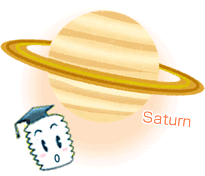
Episode 31: The World’s Astronomers Focus on Saturn
Hello everyone. Humans have been fascinated by space since long ago. When people realized that the earth revolves around the sun instead of the other way around, they started wondering more, “Could there be life beyond Earth?” There are two basic conditions for life: 1. There must be water. 2. There must be air. We have discovered that a planet exists about 459 light-years from Earth which is about the same size. It is thought probable that there is life. However, we may not have to go so far. The chance has risen that life may exist within our solar system. The secret is Saturn.
The world’s astronomers are now excitedly observing Saturn’s moon Enceladus. It sounds like the name of a dinosaur, doesn’t it?

When we think of Saturn, we think of its rings. Along with its rings, it has 60 moons. One of these moons, Enceladus, has now come under attention because water was found there. Enceladus is covered in thick ice, under which there is a great liquid ocean. There are three valleys on Enceladus where water shoots up at intervals like at a spring. At the temperature of space, −270.42 °C, vapor freezes in an instant. Saturn’s rings are composed almost entirely of ice, in pieces of about 3 cm. Space contains a lot of radiation, so, in principle, the ice in the rings should get blacker and blacker from the radiation, but, in fact, it is always sparkling because new ice is generated like this. This and many other facts about Saturn have been elucidated by Cassini, a satellite studying Saturn. NASA launched Cassini on October 15, 1997. The dimensions of the main body were height 6.8 m and width approximately 4 m, and its weight was 5.8 t. It was powered by three nuclear batteries (radioisotope power generators). Cassini entered Saturn’s orbit on June 30, 2004. This was about six and a half years after it was launched. The distance directly from Earth to Saturn is about 1.3 billion km, but Cassini made a number of detours, so it flew about 3.5 billion km before reaching Saturn. Why did it take the long way? It was not just in the spirit of tourism, as in “Since we came all the way to out to space, we might as well visit other planets.” Cassini visited first, in order, Venus, Venus, Earth, and Jupiter. Cassini did not have enough power to fly nonstop to Saturn on its own, so three planets’ gravity (two times Venus) was used for a “spring effect” to continue its flight. This is called a “gravity assist” or “swing-by.” In other words, if it wasn’t for the power of springs in space, we wouldn’t be able to unlock the secrets of the universe. The Saturn probe Cassini is named after the astronomer Giovanni Cassini. Giovanni Cassini, by the way, was an Italian-born French astronomer. He discovered several moons of Saturn as well as the Cassini Division.
The French astronomer Jacques Cassini was Cassini’s son. The French astronomer and cartographer César Cassini was Jacques’s son and invented Cassini projection. The French astronomer Jean-Dominique Cassini (Cassini IV) was César’s son. The French botanist Henri Cassini was Jean-Dominique’s son. It was a long line of astronomers.
Well, that’s all for today. Did anyone remember “Springs in Space” (#4) ? On April 11, 1970, Apollo 13 lifted off for the Moon with Commander Jim Lovell and two other astronauts. An explosion occurred about 56 hours later (320,000 km from the Earth, 60,000 km to the moon). Some of the fuel cells broke down, and it seemed almost impossible to return to the Earth while maintaining all the functions of the spacecraft only with the remaining electricity. (Without electricity, oxygen cannot be produced. In addition, it is extremely cold in the spacecraft.) Space scientists were immediately sent from MIT, NASA, and other laboratories and they came to the conclusion that Apollo 13 should go around the moon and head back toward Earth. Look forward to the next episode, #32! See you next time!
Written by Banekko (a child of spring)

